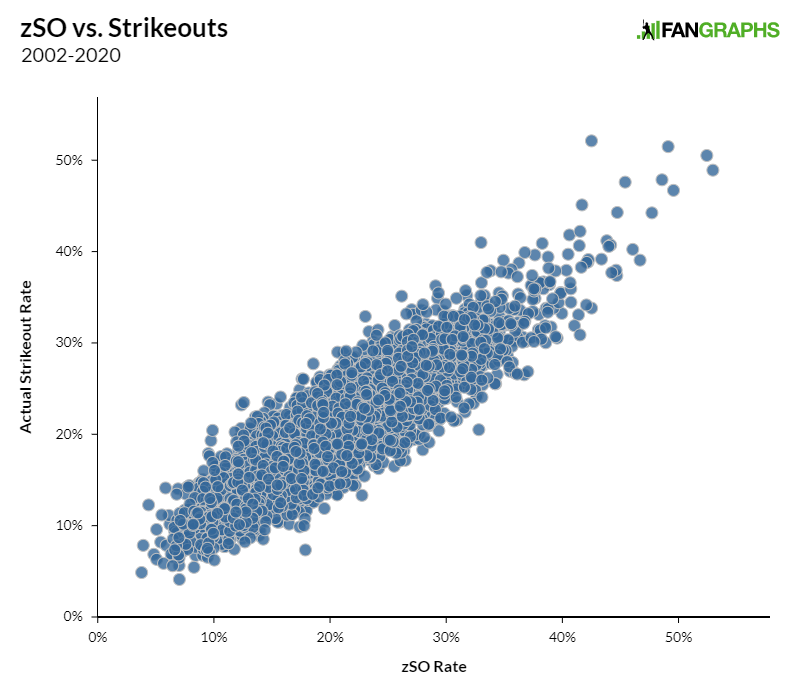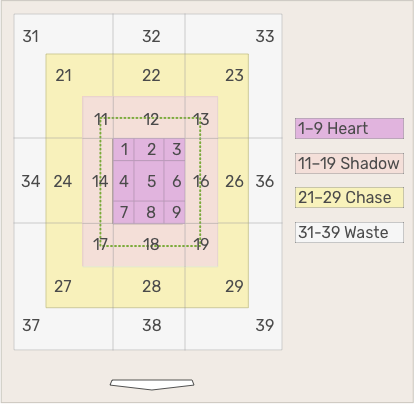If you are a regular FanGraphs reader, chances are that you’re aware of the rise in strikeouts across the majors. At this point, bemoaning the rise in strikeouts is an essential component of the baseball media apparatus. Every season is accompanied by pieces on the subject. I found this type of article going as far back as 2013, and they have been especially prevalent in recent seasons. It seems to be a rite of passage to put out a piece on the increasing strikeout rate, so as a newly minted member of the baseball writing community, here is my entry in the genre.
For context, the league-wide strikeout rate has increased every season since 2005, when it sat at 16.4%. In 2021, that figure has risen to 24.1%. That is a 47% increase in 16 seasons. Not only has the strikeout percentage monotonically increased, but the rate at which it is increasing is growing. From 2005-09, the rate increased by 9.7%; from 2010-14, 10.3%. In the most recent five seasons, the strikeout rate increased by 11.6%.
The question is always who and what is driving this phenomenon, and the answer is almost always “well, there are a few factors at play.” One angle that I thought has been under-researched is hitter behavior with two strikes. You may have heard your favorite local newspaper columnist bemoan the idea that hitters do not have a two-strike approach anymore, that all they try to do is hit home runs, which has led to all the strikeouts. Of course, this type of thinking is reductive, mostly because it does not even consider the role of the pitcher. Nevertheless, many have discussed two-strike results, though more anecdotally than quantitatively. So let’s investigate this aspect of the strikeout rate problem first. The following is the strikeout rate and wOBA in plate appearances that reach two-strike counts in the Statcast era:
Two Strike Performance
| Season |
K% |
wOBA |
| 2015 |
40.4 |
.240 |
| 2016 |
.41.1 |
.243 |
| 2017 |
41.5 |
.247 |
| 2018 |
42.2 |
.241 |
| 2019 |
42.8 |
.247 |
| 2020 |
43.2 |
.245 |
| 2021 |
44.6 |
.229 |
SOURCE: Baseball Savant
Like the overall strikeout rate, the strikeout rate in these plate appearances is monotonically increasing but much more slowly. Year-over-year, the increase never exceeds 2% besides this season and 2020 (about 3%). I will note we are only about a month and a half into the season and given the weather, league offense is at its nadir, so I would expect this to regress some. wOBA with two strikes has jumped in the Statcast era and this season so far has stuck out like a sore thumb. The weather caveat applies here also, as does the caveat that we are dealing with only a fraction of the plate appearances in 2021 versus all other seasons besides 2020 (for obvious reasons). This information seemingly debunks the awful two strike approach theory, at least within the defined time frame. Hitters are barely striking out more when they get to two strikes and their overall performance has not changed much season-over-season, 2021 notwithstanding. If we dig further into two strike behavior, the idea that hitters have drastically changed when they are confronted with two strikes does not track:
Two Strike Behavior
| Season |
SwStr% |
CS% |
Swing% |
Chase% |
BBE% |
| 2015 |
13.1 |
4.4 |
59 |
45.8 |
23.8 |
| 2016 |
13.3 |
4.4 |
58.8 |
44.7 |
23.2 |
| 2017 |
13.5 |
4.4 |
58.5 |
43.6 |
22.8 |
| 2018 |
13.8 |
4.5 |
58.6 |
43.1 |
22.6 |
| 2019 |
14 |
4.4 |
58.4 |
43.5 |
22 |
| 2020 |
14.1 |
4.6 |
57.5 |
42.8 |
21.8 |
| 2021 |
14.4 |
5.1 |
58 |
42.1 |
21.6 |
SOURCE: Baseball Savant
I will note that the chase rate calculation is based on my own filtering of the Statcast data from Baseball Savant. The swinging strike rate has increased every season and the rate at which balls are put in play with two strikes has decreased every year, which gives some credence to the complaint about hitter behavior. I would argue the changes are so small, however, that drastic claims about today’s players are not warranted. We are talking about 1.3 percentage points in terms of swinging strike rate, and 2.2 percentage points in balls in play rate from 2015-21. I do not think anyone without access to this kind of statistical information can really tell the difference between those figures when watching the game. The swing rate with two strikes has been very stable in this era. In terms of chase rate, batters have become more discerning, which can only be construed as a positive development, assuming we believe it’s better to have fewer strikeouts.
Interestingly, the rate of called strikes as a percentage of total two-strike pitches has seen a noticeable jump in 2021. Devan Fink wrote about how pitchers have become more aggressive throwing the ball in the zone this season with the advent of the new ball. I would imagine this is the impetus for the growth in the percentage of strikeouts via the called strike.
Overall, the differences in two-strike performances between seasons do not seem substantial enough to explain the acceleration of the strikeout rate growth. Maybe it is not batter performance in two strike counts, but instead a notably higher percentage of total pitches being thrown with two strikes?
Percentage of Pitches in Each Count
| Season |
0-0 |
0-1 |
0-2 |
1-0 |
1-1 |
1-2 |
2-0 |
2-1 |
2-2 |
3-0 |
3-1 |
3-2 |
| 2015-20 |
25.8 |
12.8 |
6.5 |
10.1 |
10.2 |
9.5 |
3.5 |
5.3 |
8.1 |
1.1 |
2.2 |
4.9 |
| 2021 |
25.5 |
12.5 |
6.7 |
10.2 |
10 |
9.5 |
3.5 |
5.3 |
8.3 |
1.2 |
2.3 |
4.9 |
SOURCE: Baseball Savant
There is basically no difference between 2021 and the preceding five seasons combined. The count-based run values are more of a mixed bag with no discernible trend.
Run Values by Count
| Season |
0-0 |
0-1 |
0-2 |
1-0 |
1-1 |
1-2 |
2-0 |
2-1 |
2-2 |
3-0 |
3-1 |
3-2 |
| 2015-2020 |
0.009 |
0.008 |
0.018 |
0.008 |
0.001 |
0.016 |
0.025 |
0.002 |
0.003 |
-0.009 |
-0.008 |
0.013 |
| 2020 |
0.024 |
-0.079 |
-0.067 |
0.176 |
0.047 |
0.142 |
0.357 |
0.002 |
0.056 |
-0.15 |
-0.121 |
-0.098 |
SOURCE: Baseball Savant
Run Values per 100 Pitches Thrown
Two strike performance changes does not seem notable in recent vintage. In fact, the swinging strike rates in all counts have effectively increased at the same rate across all counts.

The last thing I investigated was looking at pitch types and seeing if any groups of pitches are more responsible for the rate of whiffs than the others. Here there are more interesting trends.

Neither breaking pitches nor offspeed pitches have seen much of an influx in swinging strikes. Hitters have struggled more with fastballs, on the other hand, in all situations. (Another hat tip to Devan Fink, who wrote about the unusually large increase in fastball velocity in the month of April this season.) Pitchers’ fastballs are becoming tougher to time-up and now that they are becoming more aggressive throwing the ball in the zone, they are inducing more swinging strikes with those pitches.
The league’s two-strike approach does not seem to be having an outsized effect on the rise in strikeouts, at least in this most recent era of baseball. There are small upticks in a few relevant metrics, but more of the increase has to do with swings and misses in all counts, especially on fastballs. This count-based analysis yielded similar results to an excellent piece from Chet Gutwein here at FanGraphs. He found that not only has the league’s swinging strike rate on fastballs increased more relative to other pitch types, but fastballs high in the zone were mostly to blame due to the continuing growth of velocity and, as a consequence, spin rate.
As the league tries to address the issue of fewer balls in play now and in the future, finding a way to combat the rise in pitcher velocity should be one of the first items on the docket. The fact that pitches are moving more than ever does not appear to be as large a factor, given the changes in whiff rates on breaking and offspeed pitches. Moving the mound back, which will be implemented in the Atlantic League this season, and giving hitters more time to react seems like a good start. After parsing through the two strike data, it seems like rectifying the lack of formidable two strike approaches across the majors is not the silver bullet many believe. Digging further into the data by pitch type in all counts, the main issue is rising whiff rates on fastballs, which Chet Gutwein opined on in his own piece I referenced above. So maybe combating velocity is the elusive silver bullet? Without a relatively controlled experiment we cannot say for certain. But we can say that hitters being criticized for forgoing any semblance of a two strike approach and placing the blame on them for the rise in strikeouts is most likely a futile exercise.




